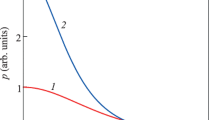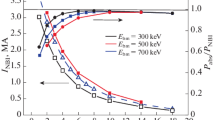Conclusion
In this paper we have examined various aspects regarding high-density operation in tokamaks and in particular the density limit, the plasma detachment, the MARFE formation and the fuelling efficiency. As regarding the density limit, both experimental findings and theoretical model indicate that the plasma current and the total input power are relevant in limiting the edge density that can be sustained in a tokamak discharge: radiation losses and SOL momentum and energy conservation are the underlying mechanisms. In the latest divertor experiments, operating in the detached regime, the influence of the input power seems to vanish or even disappear. Edge phenomena such as plasma detachment, occurring beyond a density threshold that can be lowered by means of impurity injection, can lead to the almost complete exhausting of the heating power by radiation which is greatly helpful for the design of the divertor plates. The compatibility of H-mode operation with this regime is still under investigation. The MARFE phenomenon, sometimes precursor of a major disruption, is now understood in terms of a radiation induced thermal instability. Finally, experiments performed in order to investigate the fuelling efficiency of the gas puffing technique have shown that at high density this technique becomes rather inefficient, thus indicating that pellet injection still remains an essential requirement to fuel the reactor plasma. The drop of the fuelling efficiency of gas-puffing at high density can be accounted for by collision phenomena taking place in the SOL.
Similar content being viewed by others
References
Lawson J. D.,Proc. Phys. Soc. B,70 (1957) 6.
Wesson J.,Tokamaks, 2nd edition (Oxford University Press, Oxford UK) 1997.
Janeshitz G.,Plasma Phys. Control. Fusion,37 (1995) A19.
Coppi B., Airoldi A., Bombarda F. et al., inFusion Energy 1996, Proceedings of the 16th International Conference Montreal, 1996, vol.3 (IAEA, Vienna) 1997;Coppi B.,Nassi M. andSugiyama L. E.,Physica Scripta,45 (1992) 112.
Apicella M. L., Apruzzese G., Borra M. et al., Nucl. Fus.,37 (1997) 381.
Stix T. H.,Plasma Phys.,14 (1972) 367.
La Haye R. J.,Callen J. D., Chu M. S. et al., inFusion Energy 1996, Proceedings of the 16th International Conference Montreal, 1996, vol.1 (IAEA, Vienna) 1997, p. 747.
Gondhalekar A., inPlasma Physics and Controlled Nuclear Fusion Research 1978, Proceedings of the 1th International Conference Innsbruck, 1978, vol.1 (IAEA, Vienna) 1979, p. 199.
Alladio F., Apicella M. L., Apruzzese G. et al., inPlasma Physics and Controlled Nuclear Fusion Research 1994, Proceedings of the 15th International Conference Seville, 1994, vol.2, (IAEA, Vienna) 1995, p. 23.
Sestero A.,Com. Plasma Phys. Contr. Fus.,17 (1997) 341.
Murakami M., Callen J. D. andBerry L. A.,Nucl. Fusion Lett.,16 (1976) 347.
Hugill J.,High Density Operation in Dite with Neutral Beam Injection, Report CLM-R239, UKAEA, Culham (1983).
Alladio F., Bardotti G. andBartiromo R.,Nucl. Fusion,26 (1986) 11.
Greenwald M., Terry J. L., Wolfe S. M. et al., Nucl. Fusion,28 (1988) 2199.
Petrie T. W., Kellman A. G. andAli Mahdavi M.,Nucl. Fusion,33 (1993) 929.
Milora S. L., Houlberg W. H., Lengyel L. L. andMertens V.,Nucl. Fusion,35 (1995) 657.
Kamada Y., Hosogane N., Yoshino R. et al., Nucl. Fusion,31 (1991) 1827.
Stabler A., McCormick K., Mertens V. et al., Nucl. Fusion,32 (1992) 1557.
Frigione D. andPieroni L.,Density Limit in FTU during 90–91 Operation. ENEA report RT/NUCL/92/40.
Frigione D., Pieroni L., Zanza V. et al., Nucl. Fusion,36 (1996) 1489.
JETTeam, (presented bySmeulders P.,), inPlasma Physics and Controlled Nuclear Fusion Research 1990, Proceedings of the 13th International Conference Seville, 1990, vol.1, (IAEA, Vienna) 1991, p. 219.
Wagner F., Becher G., Behringer K. et al., Phys Rev. Lett.,49 (1982) 1408.
Mertens V., Herrmann A., Kallenback A. et al., inFusion Energy 1996, Proceedings of the 16th International Conference Montreal, 1996, vol.1 (IAEA, Vienna) 1997, p. 413.
Lang P.T.,Buchl K.,Kaufmann M.et al., Pellet Injection into Asdex Upgrade Plasmas with Improved Scenario from the Magnetic High Field Side, Max PlanckIPP report 1/304 (1996).
Pegourie B. andGarzotti L., inControlled Fusion and Plasma Physics, Proceedings of the 24th EPS Conference, Berchtesgaden, 1997, part 1 (European Physical Society, Geneva) 1997, p. 153.
Shuller F.C.,Plasma Phys Contr. Fusion,37 (1995) A135.
Spitzer L. andHarm, R.,Phys. Rev.,89 (1953) 977.
Alladio F., Apicella M. L., Apruzzese G. et al., inPlasma Physics and Controlled Nuclear Fusion Research 1994, Proceedings of the 15th International Conference Seville, 1994, vol.2 (IAEA, Vienna) 1995, p. 23.
Bracco G. andThomsen K.,Nucl. Fusion,37 (1997) 759.
Allen J., Austin G. E., Axon K. D. et al., inPlasma Physica and Controlled Nuclear Fusion Research 1986, Proceedings of the 11th Int. Conference Kyoto, 1986, vol.1 (IAEA, Vienna) 1987, p. 227.
Borras K.,Nucl. Fusion,31 (1991) 1035.
Borras K., Campbell D. J., Clement S. et al., Nucl. Fusion,33 (1993) 63.
Borras K., Schneider R. andFarengo R.,Nucl. Fusion,37 (1997) 523.
Pitcher C. S. andStangeby P. C.,Plasma Phys. Control. Fusion,39 (1997) 779.
LaBombard B., Goetz J., Kurz C. et al., Phys. Plasmas,2 (1995) 2242.
Schivell J.,Rev. Sci. Instrum.,58 (1987) 12.
Terry J. L., Marmar E. S., Wolfe S. M. et al., Bull. Am. Phys. Soc.,26 (1981) 886.
Lipshultz B. et al., Nucl. Fusion,24 (1984) 977.
Alladio F., Bartiromo R., Casali B. et al., Phys. Lett. A,90 (1982) 405.
Lipshultz B.,J. Nucl. Mat.,145 (1987) 15.
Stringer T. E., inControlled Fusion and Plasma Physics, Proceedings of the 12th EPS Conference Budapest, 1985, part 1 (European Physical Society, Geneva) 1997, p. 86.
Author information
Authors and Affiliations
Rights and permissions
About this article
Cite this article
Frigione, D. High-density operation in tokamaks. Riv. Nuovo Cim. 22, 1–37 (1999). https://doi.org/10.1007/BF02872267
Received:
Published:
Issue Date:
DOI: https://doi.org/10.1007/BF02872267




